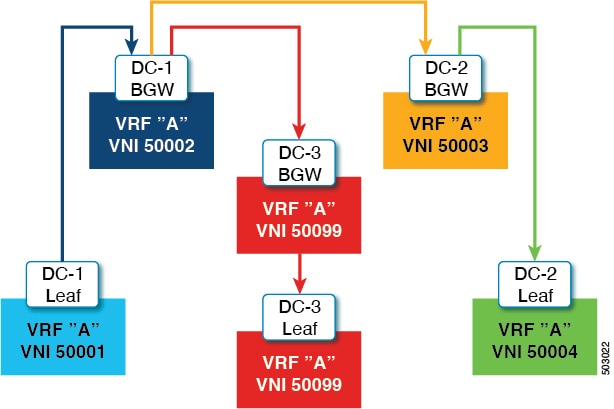About VXLAN BGP EVPN
About RD Auto
The auto-derived Route Distinguisher (rd auto) is based on the Type 1 encoding format as described in IETF RFC 4364 section 4.2 https://tools.ietf.org/html/rfc4364#section-4.2. The Type 1 encoding allows a 4-byte administrative field and a 2-byte numbering field. Within Cisco NX-OS, the auto derived RD is constructed with the IP address of the BGP Router ID as the 4-byte administrative field (RID) and the internal VRF identifier for the 2-byte numbering field (VRF ID).
The 2-byte numbering field is always derived from the VRF, but results in a different numbering scheme depending on its use for the IP-VRF or the MAC-VRF:
-
The 2-byte numbering field for the IP-VRF uses the internal VRF ID starting at 1 and increments. VRF IDs 1 and 2 are reserved for the default VRF and the management VRF respectively. The first custom defined IP VRF uses VRF ID 3.
-
The 2-byte numbering field for the MAC-VRF uses the VLAN ID + 32767, which results in 32768 for VLAN ID 1 and incrementing.
Example auto-derived Route Distinguisher (RD)
-
IP-VRF with BGP Router ID 192.0.2.1 and VRF ID 6 - RD 192.0.2.1:6
-
MAC-VRF with BGP Router ID 192.0.2.1 and VLAN 20 - RD 192.0.2.1:32787
About Route-Target Auto
The auto-derived Route-Target (route-target import/export/both auto) is based on the Type 0 encoding format as described in IETF RFC 4364 section 4.2 (https://tools.ietf.org/html/rfc4364#section-4.2). IETF RFC 4364 section 4.2 describes the Route Distinguisher format and IETF RFC 4364 section 4.3.1 refers that it is desirable to use a similar format for the Route-Targets. The Type 0 encoding allows a 2-byte administrative field and a 4-byte numbering field. Within Cisco NX-OS, the auto derived Route-Target is constructed with the Autonomous System Number (ASN) as the 2-byte administrative field and the Service Identifier (VNI) for the 4-byte numbering field.
2-byte ASN
The Type 0 encoding allows a 2-byte administrative field and a 4-byte numbering field. Within Cisco NX-OS, the auto-derived Route-Target is constructed with the Autonomous System Number (ASN) as the 2-byte administrative filed and the Service Identifier (VNI) for the 4-byte numbering field.
Examples of an auto derived Route-Target (RT):
-
IP-VRF within ASN 65001 and L3VNI 50001 - Route-Target 65001:50001
-
MAC-VRF within ASN 65001 and L2VNI 30001 - Route-Target 65001:30001
For Multi-AS environments, the Route-Targets must either be statically defined or rewritten to match the ASN portion of the Route-Targets.
https://www.cisco.com/c/en/us/td/docs/switches/datacenter/nexus9000/sw/7-x/command_references/configuration_commands/b_N9K_Config_Commands_703i7x/b_N9K_Config_Commands_703i7x_chapter_010010.html#wp44988937104-byte ASN
The Type 0 encoding allows a 2-byte administrative field and a 4-byte numbering field. Within Cisco NX-OS, the auto-derived Route-Target is constructed with the Autonomous System Number (ASN) as the 2-byte administrative filed and the Service Identifier (VNI) for the 4-byte numbering field. With the ASN demand of 4-byte length and the VNI requiring 24-bit (3-bytes), the Sub-Field length within the Extended Community is exhausted (2-byte Type and 6-byte Sub-Field). As a result of the length and format constraint and the importance of the Service Identifiers (VNI) uniqueness, the 4-byte ASN is represented in a 2-byte ASN named AS_TRANS, as described in IETF RFC 6793 section 9 (https://tools.ietf.org/html/rfc6793#section-9). The 2-byte ASN 23456 is registered by the IANA (https://www.iana.org/assignments/iana-as-numbers-special-registry/iana-as-numbers-special-registry.xhtml) as AS_TRANS, a special purpose AS number that aliases 4-byte ASNs.
Example auto derived Route-Target (RT) with 4-byte ASN (AS_TRANS):
-
IP-VRF within ASN 65656 and L3VNI 50001 - Route-Target 23456:50001
-
MAC-VRF within ASN 65656 and L2VNI 30001 - Route-Target 23456:30001
 Note |
Beginning with Cisco NX-OS Release 9.2(1), auto derived Route-Target for 4-byte ASN is supported. |





 Feedback
Feedback